Tools and Their Options
The left panel in AKVIS OilPaint (Toolbar) contains three groups of tools: pre-processing, post-processing, and additional tools. Different tools are visible depending on the active tab - Before or After.
| Toolbar Before tab |
Toolbar After tab |
Hint: Use the buttons  and
and  in the Control Panel or the hot-keys Ctrl+Z/Ctrl+Y to undo/redo the operations made with the tools:
in the Control Panel or the hot-keys Ctrl+Z/Ctrl+Y to undo/redo the operations made with the tools:
![]() ,
, ![]() ,
, ![]() ,
, ![]() ,
, ![]() ,
, ![]() .
.
Pre-Processing Tools (on the Before tab):
- Quick Preview
 switches on/off the preview window. It is a square frame outlined with the "marching ants" that displays changes made in the Painting and Decoration tabs.
switches on/off the preview window. It is a square frame outlined with the "marching ants" that displays changes made in the Painting and Decoration tabs.
You can drag the preview square to any position with the left mouse button or with the double click. This lets you quickly preview the effect in different areas of the image. To compare the result of automatic conversion with the original picture, click and keep mouse pressed within the preview area.

Preview WindowYou can adjust the preview window size in the program's Preferences
 .
.
- Crop
 (in the standalone version) lets you cut off unwanted areas in the image.
The tool is useful when you want to improve the image composition, straighten a crooked photo, turn a horizontal photo into a vertical one and contrariwise.
(in the standalone version) lets you cut off unwanted areas in the image.
The tool is useful when you want to improve the image composition, straighten a crooked photo, turn a horizontal photo into a vertical one and contrariwise.
Note: This tool is applied to the original image! Use it before the oil effect.
You can change the crop area by dragging the sides and the angles of the bounding frame.
Use the buttons in the Settings Panel to control the tool:
To apply the result and remove the areas outside the frame, press OK or use Enter. To cancel the operation and exit the tool, press Cancel or use the Esc-key. To restore the original area keeping the tool active, press Reset button.

Crop ImageAdjust the crop parameters:
You can choose the size of the crop rectangle using the Ratio or Fixed Size options.
If the External Area check-box is enabled, you can change the color and opacity of the outer parts.
- Stroke Direction tool
 gives you full control over the strokes. With this technique you can achieve truly realistic paintings with human hair, patterns, and textures going in the right direction.
gives you full control over the strokes. With this technique you can achieve truly realistic paintings with human hair, patterns, and textures going in the right direction.
Note: This feature is only available for advanced licenses (Home Deluxe, Business).
Add the guiding lines with this tool, and the program will re-make the painting following the new direction. The changes will be shown in the preview window. To process the entire image, click
 .
.

Automatic Brush Strokes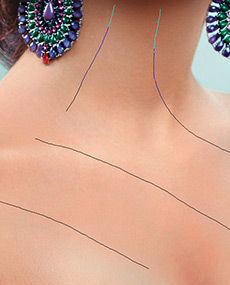
Guiding Lines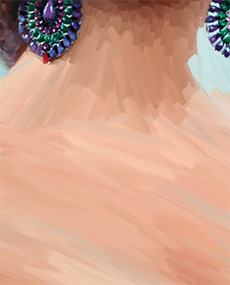
Changing DirectionHint: You can save
 and load
and load  the guiding lines created with this tool. The lines loaded into the program automatically adapt to the image size.
the guiding lines created with this tool. The lines loaded into the program automatically adapt to the image size.
Eraser
 lets you edit and remove the guiding lines drawn with the Stroke Direction tool
lets you edit and remove the guiding lines drawn with the Stroke Direction tool  . The size of the eraser can be adjusted by right-clicking on the image.
. The size of the eraser can be adjusted by right-clicking on the image.
Post-Processing Tools (on the After tab, for Deluxe/Business):
Attention! The tools ![]() ,
, ![]() ,
, ![]() ,
, ![]() are only available under the Home Deluxe/Business licenses, on the After tab. Use them at the final step. If you re-run the image processing
are only available under the Home Deluxe/Business licenses, on the After tab. Use them at the final step. If you re-run the image processing  , the changes made with the post-processing tools will be lost!
, the changes made with the post-processing tools will be lost!
Watch the video tutorial that demonstrates how to use the post-processing tools.
The options of these tools are shown in a pop-up box which appears after right-clicking on the image.
- Smudge
 is used to manually refine the image by removing paint irregularities. It mixes colors by displacing pixels, like a finger passing through wet paint. The tool lets you quickly add a handmade touch to your oil painting.
is used to manually refine the image by removing paint irregularities. It mixes colors by displacing pixels, like a finger passing through wet paint. The tool lets you quickly add a handmade touch to your oil painting.
The tool's parameters:
Size (1-300). The maximum width of a line drawn with the tool.
Hardness (0-100). The amount of blurriness of the outer edge. The higher the value, the harder the brush edge is.
Strength (1-100). The intensity of smearing the paint in the brush stroke. The higher the value, the more color is smeared.

Oil Painting Effect
Using Smudge - History Brush
 lets you fade the effect and restore the image to its original state. You can choose the mode of the tool: edit all changes or only brushes keeping the oil effect.
lets you fade the effect and restore the image to its original state. You can choose the mode of the tool: edit all changes or only brushes keeping the oil effect.
The tool's parameters:
Restore to Original. If the check-box is enabled, the tool lets you weaken the oil painting effect, as well as the result of the post-processing brushes. If the check-box is disabled, the tool edits only these brushes but does not affect the oil effect.
Size (1-500). The maximum width of a line made by the brush.
Hardness (0-100). The blurriness of the tool's edges. The less the value the more blurry the tool's edges become. At value 100% the border between the brush's edges and the background is very distinct; at lower values the transition between these areas is smoother.
Strength (1-100). The degree of restoration to the original state. At lower values there will be less restoration and more blending with the effect; at value 100% the original image will be restored more completely.

Oil Effect
Using History Brush - Oil Brush
 is designed to strengthen the oil effect on desired areas. This tool lets you make high-quality strokes that look like made with a real oil paint brush.
is designed to strengthen the oil effect on desired areas. This tool lets you make high-quality strokes that look like made with a real oil paint brush.
- Gradient line with the current color in the center.
On the left side is +30% black, and on the right side +30% white. - The previously selected color.
- The current color of the pixel where the cursor is.
- Colors of surrounding pixels.
- Average colors from areas of 3x3, 5x5, 11x11, 31x31, 51x51, 101x101 px.
Size (2-150). The maximum line width which can be drawn with the brush.
Relief (0-100). The prominence of stroke details. As this parameter is increased, the pattern left by the brush's hairs in the paint is more pronounced and the relief of strokes is stronger.

Relief = 10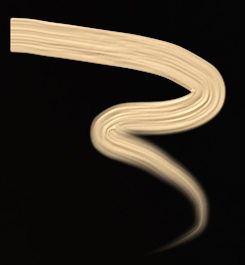
Relief = 100Paint Reserve (0-100). The length of the brush stroke. When the paint runs out, the brush stops painting on the surface and leaves a raised, faded stroke of paint.
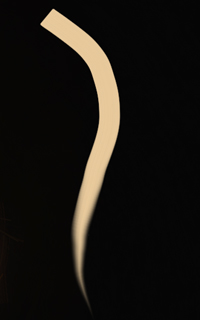
Paint Reserve = 10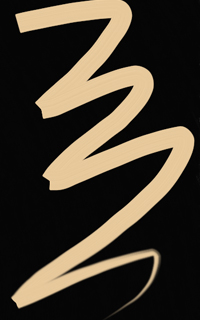
Paint Reserve = 50Color Mixing. This option defines the state of the paint in a stroke. When the check-box is enabled, the brush strokes will mix together as if the paint is wet. If the check-box is disabled, the paint will behave as if it is drying, and the strokes will not mix.

Color Mixing is disabled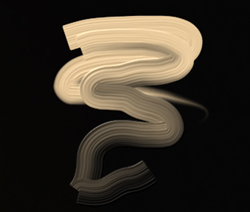
Color Mixing is enabledCleaning. This option works only if Color Mixing is active. If the check-box is enabled, the brush will clean for each new stroke, a new line will start with the defined color. When it is disabled, a new stroke will be drawn with the color that brush had at the end of the previous stroke.

Cleaning is disabled
Cleaning is enabledFlat Brush. The check-box changes the shape of the edges of the brush strokes. If it is enabled, the strokes look like drawn with a flat brush or a palette knife. When this option is disabled, the brush strokes look like created with a round brush or as if paint squeezed out of a tube.

Flat Brush is enabled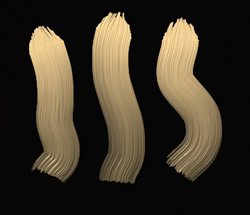
Flat Brush is disabledColor. The color square on the Toolbar under the Oil Brush displays the selected color for this tool. There are two ways to change colors for the brush:
Double-click within the plate and choose a color from the Select Color dialog.
Left-click on the square (or use the I-key) to activate the Eyedropper tool, then pick a color from the image.

EyedropperAround the eyedropper's tip over the image there is a color ring that helps you select colors more precisely. If it's hard to catch a certain color, you can see adjacent tints and select the color on the ring while holding the Ctrl-key.
There are 5 sectors on the color ring:
- Gradient line with the current color in the center.
- 3D Brush
 lets you bring volume and relief to your painting. The tool draws prominent strokes without changing colors.
lets you bring volume and relief to your painting. The tool draws prominent strokes without changing colors.
Size (2-300). The maximum width of a line drawn with the tool.
Smearing (0-100). The parameter defines the state of the paint when drawing with the brush. At value = 0 the strokes do not mix together. The higher the value, the more strokes will be smeared and mix.

Smearing = 0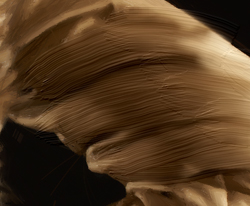
Smearing = 90Relief (0-100). The prominence of the traces of the brush strokes. The higher the value, the more expressive the strokes are. At low values it gives the smoothing effect.
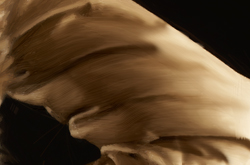
Relief = 10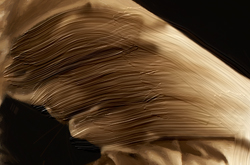
Relief = 50Flat Brush. It works similarly to the same option of the Oil Brush.
Additional Tools (available on both tabs, for all licenses):
- Hand
 lets you scroll the image when it does not fit within Image Window at the desired scale. To use it, click the button, bring the cursor over the image, and while keeping the left mouse button pressed move in the desired direction. The hot-key is H.
lets you scroll the image when it does not fit within Image Window at the desired scale. To use it, click the button, bring the cursor over the image, and while keeping the left mouse button pressed move in the desired direction. The hot-key is H.
Double-clicking the tool's icon
 in the Toolbar makes the image fit the window.
in the Toolbar makes the image fit the window.
- Zoom
 lets you change the image's scale. To zoom in, left-click in the image. To zoom out, left-click with Alt in the image. The hot-key is Z.
lets you change the image's scale. To zoom in, left-click in the image. To zoom out, left-click with Alt in the image. The hot-key is Z.
Double-clicking the tool's icon
 makes the image scale to 100% (actual size).
makes the image scale to 100% (actual size).
